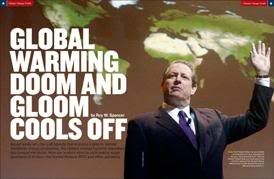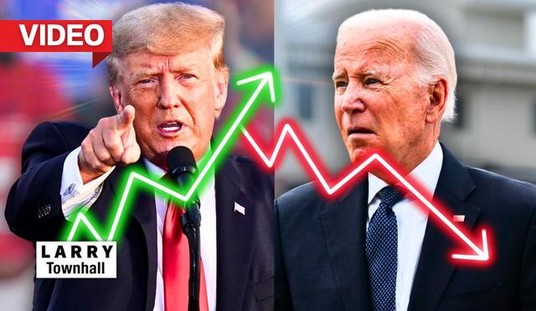Editors' note: This article is a free preview from Townhall Magazine. Click here to subscribe and receive a free copy of either Ann Coulter, Michael Yon, or Rebecca Hagelin's book.
Based solely on a far-Left agenda that includes a plan to control worldwide energy production, the climate change hysteria movement has jumped the shark. Now our leaders need to start asking tough questions of Al Gore, the United Nations IPCC and other alarmists.
Reducing your carbon footprint in the wake of Al Gore’s “An Inconvenient Truth” was the hottest thing for liberal elites and celebrities alike, but their sell to the American people seems to have gotten stale.
It appears that politicians haven’t lost interest, though. Even though global temperatures stopped rising in 2001 and despite the almost total failure of the Kyoto Protocol to reduce carbon dioxide (CO2) emissions in the European Union, President-elect Obama continues to make green energy and a new green economy one of his top agenda items. The Supreme Court’s 2008 decision that carbon dioxide is indeed a “pollutant”— and its instruction to the EPA that it must decide whether to regulate CO2 under the Clean Air Act—offers Obama the opportunity to force new and costly carbon emissions regulations on businesses large and small.
Even if the EPA decides not to regulate CO2, the Democrat-controlled Congress will at some point in the next two years be debating legislation that would cap carbon dioxide emissions and set up a mechanism for the trading of carbon emission permits between companies. A massive new government bureaucracy will be formed, and when it comes to something as ethereal as trying to document and limit the amount of carbon dioxide a company is allowed to emit, the opportunities for fraud and gaming the system will be limited only by one’s imagination.
Yet even as our country careens toward government-mandated reductions in carbon dioxide emissions, the scientifi c basis for doing so is gradually eroding away. Our new understanding of how the climate system operates will eventually lead to the realization that what Al Gore likes to call the “climate crisis” has been based upon the greatest scientifi c faux pas in history.
There are two new scientifi c fi ndings that will have a huge impact on the global warming debate—if they are allowed to see the light of day. The fi rst is compelling new evidence that suggests that global warming has been mostly natural, the result of an internally generated climate fl uctuation called the Pacifi c Decadal Oscillation. The second is the increasing amount of observational evidence that the climate system is largely insensitive to our greenhouse gas emissions.
HOW DID WE GET HERE?
What all of this would mean is that Mother Nature doesn’t really care how big your carbon footprint is and that she is going to cause chaotic changes in climate whether or not we humans are around to blame it on ourselves.
Recommended
But let’s fi rst examine how we got to the point where Western civilization now believes that the tailpipe emissions from SUVs are cooking the planet. Carbon dioxide is an odorless, colorless gas that is essential for life on Earth—it is required for a process called photosynthesis. And without photosynthesis, life on Earth is pretty much done for.
Despite its central role as an elixir of life, there is surprisingly little CO2 around us: only 39 CO2 molecules out of every 100,000 molecules of air. And it takes humanity fi ve years to increase that concentration by one more molecule of CO2 per 100,000 molecules of air.
So how did such a natural—indeed, essential—component of life get such a bad rap? Because the leadership of the United Nations Intergovernmental Panel on Climate Change (IPCC) has been working for 20 years to build a scientifi c case for the view that more carbon dioxide in the atmosphere has caused the global warming we have experienced over the last 50 to 100 years and that warming is going to get much worse in the future. That carbon dioxide is a greenhouse gas is indisputable— that it has caused global warming, though, is not.
The fear of global warming has resonated with a number of politicians and entertainers who needed something to worry about, something to fi ght for and to give their lives meaning—and to make lots of money on, too. Some climate scientists have even made statements to the effect that “reducing carbon dioxide emissions is the right thing to do anyway, no matter what the science says”.
But what is the basis for such a belief? It is bothersome that the debate over whether more CO2 in the atmosphere might actually be a good thing was never allowed to occur.
The belief that everything that mankind does is bad for the environment is arbitrary and religious. Change in nature is ubiquitous, and the idea that nature cannot handle human-induced change is a romantic notion that even scientists hold on to. When nature changes all by itself, there are always winners and losers. The existence of trees on the Earth no doubt changes the climate system; why should it be any different for the existence of humans?
Given the importance of carbon dioxide to life on Earth, I would never have imagined that we would see the day when the United States Supreme Court ruled that carbon dioxide is a “pollutant,” but here we are anyway. Gore claims we dump 70 millions tons of CO2 into the atmosphere every day as if it was an “open sewer.” I say we are enhancing the productivity of life on Earth, allowing it to breathe more freely than it has been able to since prehistoric times.
Editors' note: This article is a free preview from Townhall Magazine. Click here to subscribe and receive a free copy of either Ann Coulter, Michael Yon, or Rebecca Hagelin's book.
TIME FOR A REALITY CHECK
But even if global warming is entirely man made, the regulatory path we are traveling down ignores some very stark realities. The most important reality from a practical standpoint is the fact that there are still no largescale replacements for fossil fuels. As worldwide demand for energy continues to grow, the United States has been prevented by special interests from even keeping pace with our slowly increasing need for energy.
While renewable energy sources sound attractive, the fact is that we still need electricity when the sun doesn’t shine and when the wind doesn’t blow. The world needs food, and the diversion of crops into liquid fuel production pushes those around the world who were merely malnourished into starvation.
It’s hard to tell whether the proponents of the rush to biofuels are merely misguided or actively seeking to reduce the world’s population by starving poor people. Roy Innis, chairman of the Congress On Racial Equality, has written a new book titled “Energy Keepers, Energy Killers: The New Civil Rights Battle.” Innis makes the case that it is time for people to wake up to the reality that their guilt over using fossil fuels ends up killing people, mainly the poor.
You might think hydrogen power sounds really cool, but that hydrogen has to come from somewhere—there are no hydrogen mines—and it takes energy to make it. Where will that energy come from? Unless we begin embracing more nuclear power plants and stop blocking the construction of new coal-fi red power plants, energy will become increasingly expensive … and scarce. Brownouts and blackouts are almost inevitable in the coming years.
Plug-in hybrid cars seem like a good way to reduce our dependence on petroleum, but unless we start building more nuclear plants right now, we will be simply making the problem worse.
And if you think natural gas is the answer, you need to know that Vladimir Putin and Russian natural gas company Gazprom (the largest extractor of natural gas in the world) now have greater control of the world’s natural gas market than OPEC has of petroleum. Putin is trying to buy up natural gas companies all over the world—including right here in the United States. The national security of an increasing number of European countries heavily dependent upon natural gas is now in Putin’s hands.
The truth is that there are no zero-risk, environmentally neutral energy technologies. We probably need to be doing everything—drilling, pumping, building nuclear and coal-fi red power plants, and even building some solar and wind generation capabilities where they are economically viable. But the reality is that fossil fuels will dominate the world’s energy mix for many, many years to come.
It is true that fossil fuel supplies are being slowly depleted; they are not limitless. We will indeed need new energy technologies to replace fossil fuels, but new technologies cannot be simply legislated into existence. They will instead come through free market forces. Everyone needs energy, and whoever develops economic and widely deployable replacements for fossil fuels stands to make a lot of money.
Some people might “feel” like reducing carbon dioxide emissions is the right thing to do, but feelings will not create the energy supplies mankind needs on a daily basis.
Editors' note: This article is a free preview from Townhall Magazine. Click here to subscribe and receive a free copy of either Ann Coulter, Michael Yon, or Rebecca Hagelin's book.
BAD SCIENCE AND GREATER GOVERNMENTAL CONTROL
The IPCC has advertised itself to be the most authoritative scientifi c body for keeping the world informed on man-made climate change. But the IPCC is more of a policy-oriented body that uses cherry-picked scientifi c research to further its agenda. Their enlistment of most of the world’s leading climate researchers allows them to simply dismiss any other scientists who disagree with them. Their goal has always been to build the scientifi c case for global warming being man made and damaging, thereby enabling governmental control over the world’s energy supply. The free market will no longer be free.
The IPCC is supported by climate thugs who run the website RealClimate.org where they demonize any scientists who dare to disagree with the “scientifi c consensus” on global warming. These folks still don’t realize something that even the public knows: “Consensus” is a political term, not a scientifi c one.
And in the process of achieving their goals, the leaders of the IPCC have corrupted a scientifi c discipline for their own political, philosophical, fi nancial and career-enhancement reasons. The blame does not lie with the hundreds of climate scientists involved in the IPCC effort. They are largely along for the ride, being assured of continued government funding for research to work on a topic that everyone agrees sounds important— saving the Earth from climate change.
But whereas climatology used to involve collecting and analyzing observations of the Earth in order to fi gure out how nature works, most climate research money is now funneled into increasingly expensive and complex computerized climate models—which are claimed to be correct simply because they are so expensive and so complex.
The time has long passed for Americans to demand that the activities of the IPCC be reviewed. For instance, the IPCC never seriously investigated the possibility that climate change might be largely natural. After all, natural climate variability is its enemy: It distracts from the claim that mankind is now the main driver of the climate system.
The IPCC insists that increasing CO2 due to mankind is the only known reason for global warming. And it is right—it is the only one known to IPCC scientists because they have covered their eyes and ears whenever they are confronted with evidence to the contrary. The IPCC has never asked for government funding of research to see if, just maybe, there are natural reasons for global warming.
Editors' note: This article is a free preview from Townhall Magazine. Click here to subscribe and receive a free copy of either Ann Coulter, Michael Yon, or Rebecca Hagelin's book.
NEW FINDINGS IMPACT IPCC’S POWER
And this is where new science is chipping away at the house of cards the IPCC has built for itself. I now believe that the IPCC’s most signifi cant scientifi c blunder has been its continuing insistence that global cloud cover, the main determinant of global temperatures, always remains the same. For if global cloud cover can change naturally, then global temperatures can also change naturally, and that would open the door to the possibility that global warming is more natural than man made.
The IPCC knows full well that there are natural modes of climate variability, such as El Niño, La Niña, the Pacifi c Decadal Oscillation (PDO), the Atlantic Multidecadal Oscillation and the Arctic Oscillation. But they have assumed that these forms of natural climate variability only rearrange the geographic distribution of weather patterns and clouds, not cause changes in global averages. That is presumably humanity’s job.
But now we have eight years of high-quality NASA Terra satellite data that have revealed that the PDO does indeed cause a change in global cloud cover. And when that satellite-measured change in cloud cover is put into a simple climate model and combined with the last 100 years of fl uctuations in the PDO, it can explain most of the global average temperature behavior over the last century—including 75 percent of the warming trend. It is particularly good at explaining why the period from 1940 to the late 1970s actually showed slight cooling, rather than warming, an event that has always been a thorn in the side of climate modelers.
What’s interesting about this alternative explanation for global warming is that it is based upon actual satellite observations of changes in the Earth’s radiative energy balance. In contrast, the change in the Earth’s energy balance due to increasing carbon dioxide has not been observed—instead, it must be computed theoretically.
Unfortunately, the results I just described are not yet “peer reviewed and published” science. My fi rst attempt at publication was swiftly killed in record time—two weeks after paper submission—by a single, rather hostile reviewer. It is highly unusual for peer review of a paper to come from only one peer.
So this new science can be temporarily dismissed. But it’s odd that I am one of the very few scientists who have actively researched the question: Could there be a natural explanation for global warming? The IPCC has purposely avoided the issue, and I am not aware of any government study that has been funded to answer that question.
The IPCC’s second major scientifi c blunder has been its use of computerized climate models as the ultimate authority to answer climate questions. Contrary to our actual observations of the climate system, these models predict that the little bit of warming from the extra CO2 we pump into the atmosphere will be greatly amplifi ed by changes in clouds. But the available satellite evidence of the real climate system, when interpreted properly, shows just the opposite: Clouds tend to reduce warming tendencies in the climate system, not amplify them.
The IPCC knows about this discrepancy between its models and the observations, but their explanation is that the models are right and the observations are wrong.
Without going into too much detail, it seems that much of its confusion in this regard has been due to a simple mix-up between cause and effect when observing cloud behavior. When researchers have observed fewer clouds accompanying warming, they have assumed the warming caused the cloud change—a feedback effect which would amplify warming.
But what they have ignored is the evidence that causation is actually working in the opposite direction: Fewer clouds cause the warming, not the other way around. In other words, they have not distinguished between forcing and feedback when observing cloud behavior. In very simple terms, they have mixed up cause and effect.
We have published evidence for some of this work in the scientifi c literature, but you probably never heard about it. This is presumably because the news media are not in the business of reporting good news—or of contradicting Al Gore and Leonardo DiCaprio.
If you are wondering why NASA’s James Hansen—the godfather of global warming research—thinks the climate system is hypersensitive to the extra CO2, it is because he ignores the observational evidence from today’s climate system. He instead relies upon speculative and unprovable interpretations of how the climate system was allegedly working hundreds of thousands to millions of years ago.
I am under no illusion that the new scientifi c evidence I have described will end the debate over whether mankind or nature is the primary driver of climate change. Quite the opposite, really. I am hoping that the debate will fi nally begin.
With economic hard times making any legislative efforts to punish energy use even more damaging, it is time for the public to demand some answers. We have now gone eight years without global warming, and the public is beginning to have doubts about the “scientifi c consensus”—as well it should. We cannot entrust our economic future to the political interests of the United Nations, which is misusing science in its attempt to lend scientifi c credibility to its efforts.
And if you happen to think the direction we are headed—global governance—is the way we should go anyway, then at least make your case based upon its merits, rather than through the misuse and distortion of my scientifi c discipline.
It is time for the public to tell our elected representatives to start asking some hard questions about our country’s reliance on the IPCC for defi nitive answers regarding global warming. The IPCC’s demand to be believed just because it has created the largest infrastructure and the biggest climate models should be tolerated no longer.

























Join the conversation as a VIP Member